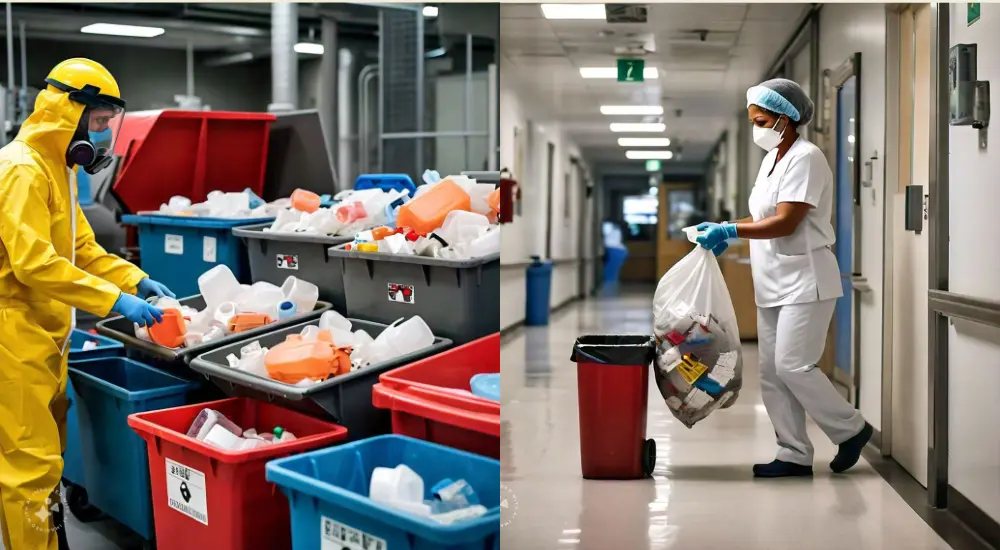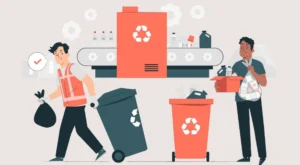Biomedical waste management is a critical aspect of healthcare operations, ensuring the safe and proper disposal of potentially hazardous materials generated in medical facilities. Effective management of biomedical waste is essential to protect public health, the environment, and healthcare workers. This article will explore the various aspects of biomedical waste management, including its importance, types, management strategies, challenges, and sustainable solutions. By the end of this article, you’ll have a clear understanding of how effective biomedical waste management contributes to a safer and healthier world.
What is Biomedical Waste?
Biomedical waste, also known as hospital waste or healthcare waste, refers to any waste produced during the diagnosis, treatment, or immunization of humans or animals. It also encompasses waste produced during research activities and the production or testing of biological products. It includes a broad range of materials, from used syringes and bandages to chemical waste and expired medications. Discarded sharps like used needles are also considered as biomedical waste. Biomedical waste is a type of biowaste which are generally of organic origin and biodegradable in nature. Proper management of this waste is vital to prevent contamination and harm to healthcare workers, patients, and the general public.
Types of Biomedical Waste
Understanding the different types of biomedical waste is crucial for effective management. The main categories include:
- Infectious Waste: Waste contaminated with blood, body fluids, or other infectious materials, such as used gloves, gauze, and surgical instruments.
- Pathological Waste: Human or animal tissues, organs, body parts, and fluids removed during surgery or autopsy.
- Sharps Waste: Items that can cause punctures or cuts, such as needles, scalpels, and broken glass.
- Chemical Waste: Discarded chemicals used in laboratories, cleaning agents, and disinfectants.
- Pharmaceutical Waste: Expired, unused, or contaminated medications and vaccines.
- Genotoxic Waste: Waste containing substances with genotoxic properties, such as certain chemotherapy drugs.
- Radioactive Waste: Waste containing radioactive substances used in medical treatments and diagnostics.
- Non-Hazardous Waste: General waste that poses no risk, such as paper, cardboard, and kitchen waste from healthcare facilities.
According to World Health Organization, 75-90% of the waste from healthcare providers is similar to household waste and can be labelled as “non-hazardous” or “general healthcare waste.” This waste mostly comes from administrative tasks, kitchens, housekeeping, packaging, and building maintenance at healthcare facilities. The other 10–25% of healthcare waste is considered “hazardous” and can cause various health and environmental risks.
Importance of Biomedical Waste Management
Biomedical waste management is crucial for protecting public health and the environment. Proper handling, treatment, and disposal of biomedical waste prevent the spread of infections and diseases, safeguarding healthcare workers, patients, and the community. It also reduces environmental pollution by preventing harmful chemicals and pathogens from contaminating air, soil, and water. Additionally, adhering to regulatory standards helps healthcare facilities avoid legal penalties and maintain their reputation. Effective biomedical waste management conserves resources through recycling and promotes sustainability, contributing to a healthier ecosystem and a safer world.
According to a recent World Health Organization (WHO) report, improper handling of biomedical waste (BMW) remains a global issue, especially amid the COVID-19 pandemic. The rapid growth of healthcare services has led to a significant increase in BMW generation. Proper segregation, collection, treatment, and disposal of biological waste are crucial to prevent the spread of infectious diseases and protect healthcare workers, waste handlers, and the public. The report indicates that over 16 million injections are administered annually worldwide, generating more than 85 million tons of BMW. With current global health challenges, proper BMW management is essential.
Biomedical Waste Management Strategies
Biomedical or healthcare waste management strategies include proper segregation, collection, transportation, treatment, and disposal. Regular staff training, use of personal protective equipment (PPE), and adherence to regulations enhance the effectiveness of these strategies.
Waste Segregation
Segregation is the first and most crucial step in biomedical waste management. Proper segregation ensures that different types of waste are handled and treated appropriately. Effective segregation reduces the risk of contamination and makes the disposal process more efficient. Waste should be segregated into the following categories:
- Yellow Bags: For infectious waste, pathological waste, and chemical waste.
- Red Bags: For contaminated waste that can be disinfected and recycled.
- Blue/White Bags: For sharps and other items that require special handling.
- Black Bags: For general waste that is non-hazardous.
Collection and Transportation
Biomedical waste must be collected and transported safely to treatment and disposal facilities. Secure, leak-proof containers should be used to prevent spills and contamination. Transportation vehicles must be equipped with safety features and clearly labelled with biohazard symbols. Waste should not be stored for more than 48 hours to prevent the growth of pathogens.
Treatment and Disposal Methods
Biomedical waste must be treated to neutralize pathogens and reduce its hazardous nature before disposal. Common treatment methods include:
- Autoclaving: Using steam under pressure to sterilize infectious waste.
- Incineration: Burning waste at high temperatures to destroy pathogens and reduce waste volume.
- Microwave Treatment: Using microwave radiation to disinfect waste.
- Chemical Treatment: Applying chemicals to disinfect and neutralize waste.
- Thermal Treatment: Using heat to treat waste without combustion.
After treatment, biomedical or healthcare waste should be disposed of in a manner that minimizes environmental impact. Treated waste can be disposed of in sanitary landfills or through other environmentally friendly methods. Sharps waste should be encapsulated in concrete or other materials to prevent injury. By following the strategies outlined in this guide, we can make significant strides toward a more sustainable and waste-free world.
For more information, you can go through the WHO Handbook on Safe Management of Wastes from Health-care Activities.
Challenges in Biomedical Waste Management
Despite the importance of proper biomedical waste management, several challenges exist:
- Lack of Awareness: Many healthcare workers may not fully understand the risks associated with improper biomedical waste management. Education and training are essential to ensure that waste is handled correctly.
- Insufficient Infrastructure: Some regions lack the necessary infrastructure, such as treatment facilities and transportation systems, to manage biomedical waste effectively. Investments in infrastructure are crucial to improving waste management practices.
- Regulatory Compliance: Keeping up with evolving regulations and ensuring compliance can be challenging for healthcare facilities. Continuous monitoring and adherence to guidelines are necessary to avoid legal penalties and ensure safe waste management.
- Cost Constraints: The costs associated with waste management, including segregation, collection, treatment, and disposal, can be significant. Healthcare facilities need to allocate sufficient resources to maintain effective waste management systems.
- Emerging Waste Streams: Advances in medical technology and treatments can lead to new types of biomedical waste. Healthcare facilities must stay updated on best practices and adapt their waste management strategies accordingly.
Solutions for Biomedical Waste Management Challenges
To address these challenges, several sustainable solutions can be implemented:
- Education and Training: Providing regular training for healthcare workers and waste handlers on proper waste management practices.
- Investment in Infrastructure: Building and maintaining facilities for waste segregation, storage, and treatment.
- Regulatory Support: Strengthening regulations and providing support for compliance.
- Financial Incentives: Offering financial incentives for facilities that implement sustainable waste management practices.
- Technological Innovation: Investing in new technologies for waste treatment and disposal.
Best Practices for Biomedical Waste Management
Here are some practices the healthcare facilities should adopt to manage effectively the healthcare waste.
- Staff Training and Education: Regular training and education programs for healthcare workers are crucial for effective waste management. Staff should be trained on waste segregation, handling, transportation, and disposal procedures. Training programs should also cover the risks associated with biomedical waste and the importance of compliance with regulations.
- Use of Personal Protective Equipment (PPE): Healthcare workers should use appropriate PPE, such as gloves, masks, and gowns, when handling biomedical waste. PPE helps to protect workers from exposure to hazardous materials and reduces the risk of infection.
- Monitoring and Auditing: Regular monitoring and auditing of waste management practices help to ensure compliance with regulations and identify areas for improvement. Healthcare facilities should conduct internal audits and inspections to assess the effectiveness of their waste management systems.
- Public Awareness Campaigns: Raising awareness about the importance of biomedical waste management among the general public can help to reduce the risks associated with improper disposal. Public awareness campaigns can educate people on how to dispose of medical waste safely and encourage responsible behaviour.
- Adoption of Technology: Advancements in technology can enhance biomedical waste management practices. Healthcare facilities should explore the use of automated waste segregation systems, waste tracking software, and advanced treatment methods to improve efficiency and safety.
- Sustainable Practices: Adopting sustainable practices in biomedical waste management can contribute to environmental conservation. Healthcare facilities should prioritize recycling, reduce the use of single-use items, and explore alternatives to hazardous materials.
FAQ
Q. What is biomedical waste?
Biomedical waste or hospital waste or healthcare waste is any waste generated during the diagnosis, treatment, or immunization of humans or animals, including materials like used syringes, bandages, and laboratory waste.
Q. What is healthcare waste management?
Healthcare or biomedical or hospital waste management is the process of handling, treating, and disposing of waste generated from healthcare activities, such as medical treatments and research, to ensure safety, prevent infections, and protect the environment. It involves proper waste segregation, collection, transportation, treatment, and disposal according to regulatory standards.
Q. Why is healthcare waste management important?
Healthcare waste management is important to prevent the spread of infections, protect public health and the environment, ensure regulatory compliance, and promote sustainable practices.
Q. What are the advantages of healthcare waste management?
The advantages of biomedical or healthcare waste management include preventing infections and disease spread, protecting healthcare workers and the public, reducing environmental pollution, ensuring regulatory compliance, and promoting resource conservation through recycling.
Q. What are key guidelines for biomedical or healthcare waste management by WHO?
The WHO guidelines for healthcare waste management include proper waste segregation, use of color-coded bins, safe collection and transportation, appropriate treatment methods (like autoclaving and incineration), staff training, use of personal protective equipment (PPE), and adherence to regulatory standards.
Q. What is Biomedical Waste Management and Handling Rules 1998?
The Biomedical Waste Management and Handling Rules 1998 are regulations established by the Indian government to ensure the proper segregation, treatment, and disposal of biomedical waste to protect public health and the environment.
Q. How to start a healthcare waste management plant?
To start a biomedical waste management plant, at first conduct a feasibility study and market research. After getting necessary permits and licenses from regulatory authorities, secure funding and investment. Choose a suitable location and build infrastructure. Then, procure equipment for waste segregation, treatment, and disposal. After that you have to hire and train staff. Implement strict safety and compliance protocols. Also, establish a waste collection and transportation network.
Q. Is hospital waste management business profitable?
Yes, hospital waste management can be profitable due to the increasing demand for safe disposal services, regulatory requirements, and opportunities for recycling and resource recovery.
Conclusion
Effective biomedical waste management is essential for protecting public health, the environment, and healthcare workers. By adopting sustainable practices, healthcare facilities can ensure the safe and proper disposal of biomedical waste. From proper waste segregation and treatment to staff training and public awareness, every step plays a crucial role in creating a safer and healthier world. Whether through segregation, treatment, or community involvement, everyone has a role to play in managing biomedical waste responsibly. As the healthcare industry continues to evolve, innovative solutions and collective efforts are needed to address the challenges of biomedical waste management and build a sustainable future.















